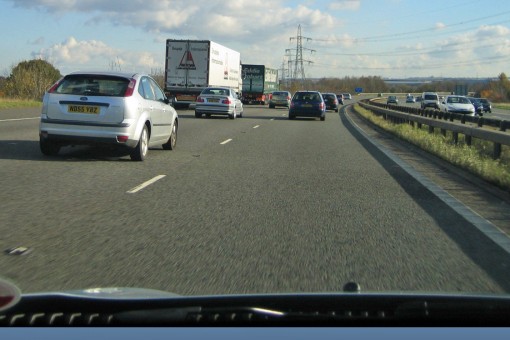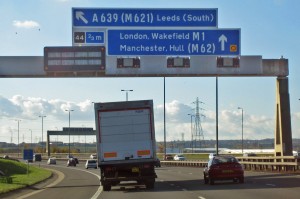Don’t panic! It’s only a motorway . . .
FOR an estimated 10-million drivers, simply venturing onto a motorway can turn an every day journey into a nightmare.
More than one third of drivers admit to regular feelings of anxiety when driving, or even considering driving on motorways according to the results of a survey by the RAC Foundation undertaken as part of National Motorway Month.
The survey also reveals that more than one in 10 drivers become ‘extremely anxious’ and may even drive a significant distance out of their way to avoid travelling on a motorway. This means that nearly 12 per cent of drivers are experiencing anxiety levels more significant than if they were attending job interviews, visiting the dentist or going on a first date.
The fear of motorways is known as Motorway Anxiety Disorder or MAD.
Symptoms of MAD include:
- Raised heart rate
- Raised blood pressure
- Excess sweating, particularly palms of hands
- Tension headaches
- Stomach cramps
- Insomnia
- Digestive problems
Through their indecisive driving behaviour, nervous drivers reinforce their own fears, cause other drivers to become frustrated by their indecisive habits, and increase the risk of accidents on motorways.
For those nervous drivers who do venture out on to the motorways, high levels of anxiety make them more likely to make mechanical errors in the operation of the vehicle as well as perceptual errors. Mistakes include:
- Leaving the indicator on
- Staying in fourth gear
- Driving at excessively slow or fast speeds
- Drive too close to the car in front
The RAC encourages nervous drivers to recognise their fears and take positive action to help curb them. MAD is both treatable and manageable.
Top five tips for nervous drivers:
1. Keep plenty of space around the vehicle and a safe distance from the car in front as this gives more time to react to changing road conditions.
2. Practice motorway driving regularly… putting it off will only worsen the problem.
3. Listen to relaxing music, practice breathing and relaxation exercises.
4. Bring along a passenger/friend who can help you stay calm.
5. Undertake post-test motorway training with a qualified instructor.
Motorway Anxiety Disorder does not necessarily result from an accident. The highest levels of anxiety are in younger and older female drivers. Younger
drivers because they lack the experience of driving on motorways and are generally less “speed” focused than their male counterparts. The lowest levels of MAD are in professional male drivers, aged 28-55.
An Australian study found that the top two situations that produced anxiety – whether the person had had an accident or not – were driving alone, especially in fog, and driving with a critical back seat driver.
Conrad King, psychologist for the RAC Foundation said: “For millions of motorists simply venturing onto a motorway can turn their journey into a nightmare. Motorway Anxiety Disorder (MAD) affects over a
third of all drivers on motorways. People may experience racing heart rate, shortness of breath, stomach cramps and excess sweating. Some drivers may even travel a long distance out-of their way to avoid having to drive on motorways.
“That people experience Motorway Anxiety Disorder (MAD) is quite natural and understandable, as motorway driving involves manoeuvring at speed. This anxiety becomes a problem when drivers fail to get enough practice on the motorways, and so don’t ever fully eliminate their fears. Some drivers build up their fears so much that they create new completely irrational fears which serve to reinforce their original anxiety.
“Motorway Anxiety Disorder can be managed through appropriate post-test driver training, through regular practice and through practicing breathing exercises and listening to calming music.”
Sarah Forrow, Campaigns Manager of the RAC Foundation said: “It is worrying that more than one in ten drivers become extremely anxious when driving or considering driving on motorways. Anxious drivers are more likely to make mechanical errors in the operation of their vehicle and may also find it more difficult to judge other vehicles’ speed, and therefore may drive too fast or slow, and too close to the car in front.
“For many nervous drivers who venture onto the motorway there is a high risk of a self-fulfilling prophecy. They drive in an indecisive way that reinforces their fears, annoys other drivers, and can increase the risk of
accidents on the motorway. We would urge anxious drivers to drive with a calm passenger, leave plenty of space between their vehicle and other vehicles, and practice their driving regularly.
“Motorway driving presents a series of unique driving conditions and it is quite understandable that people may be anxious about driving on motorways.
It is important to point out however, that motorways are our safest roads.
You are seven times more likely to be involved in an accident on an urban road than on a motorway.”
Top ten worst motorways for nervous drivers:
1) M25 – circular and congested. Chris Rea’s Road to Hell?
2) A1 (M) – changes between motorway and non-motorway standard, roundabouts.
3) M4/M5 interchange – confusing signs.
4) M1 junction 28 -32 – severe congestion, traffic coming on and off.
5) M6 Birmingham – elevated and local traffic mixes with through traffic.
6) M4 Maidenhead – highest national rate of tailgating (70 per cent).
7) M27 near Southampton – cargo port and foreign drivers.
8) M8 to Glasgow – on ramps from the right onto the outside lane.
9) M4 Wales – the height of the Severn Bridge scares drivers.
10) M18 near Doncaster – confusing as it links to M1, A1(M), M180 and M62.


